
Aaron Foyer
Vice President, Research and Analytics
The real treasure is raw minerals

Aaron Foyer
Vice President, Research and Analytics
“Treasures of the deep” is about as potent a trope as “riches of the East.” Humans have long fantasized about the idea of an abundance of wealth and resources that are found just beyond the horizon, with technology generally playing a key role.
A Macedonian king who wanted Persian gold could simply hop on his horse, organize his troops into a phalanx and try his luck in getting to Babylon to take it. Probably needs a few ships to cross the Aegean, but that’s doable.
But what if the treasures weren’t found over the sea? What if great nation-building wealth was found under the sea?
Scroll-and-sandal science: Like the middle-school science experiment of inverting a drinking glass underwater and keeping the air trapped inside, Aristotle once described how divers might explore underwater by sitting inside an inverted cauldron that would be lowered beneath the waves, staying inside an air-filled cavity — the first known description of a diving bell.
Legend has it that Aristotle’s greatest student, Alexander the Great, used one of the Greek polymath’s contraptions to study fish underwater in Persia. Almost certainly a myth, but diving bells were eventually used regularly, starting in the 17th century.

Painting of Alexander the Great being submerged in a diving bell // itoldya
Enlightenment innovators played with Aristotle’s concept, including most famously Edmund Halley and his diving bell design. The American captain William Phips purportedly used one in the late 1600s to recover an incredible fortune of silver from shipwrecks off the coasts of what are now Haiti and the Dominican Republic.
Fast forward: Modern day booty is no longer sunken galleon treasure but raw minerals. Demand for key metals is expected to jump from the growing use of modern technologies in the energy transition and electrification push.
The International Energy Agency believes a path to net-zero emissions will increase the market value of critical minerals from $325 billion today to nearly $800 billion in 2040. And the World Bank says the world will need more than 3 billion metric tons of minerals and metals for renewables and energy storage by 2050 to limit global warming to less than two degrees Celsius above pre-industrial levels.
All of this is leading companies and governments to look at developing some of the largest, most concentrated mineral deposits on Earth, found underwater in the deep blue sea.
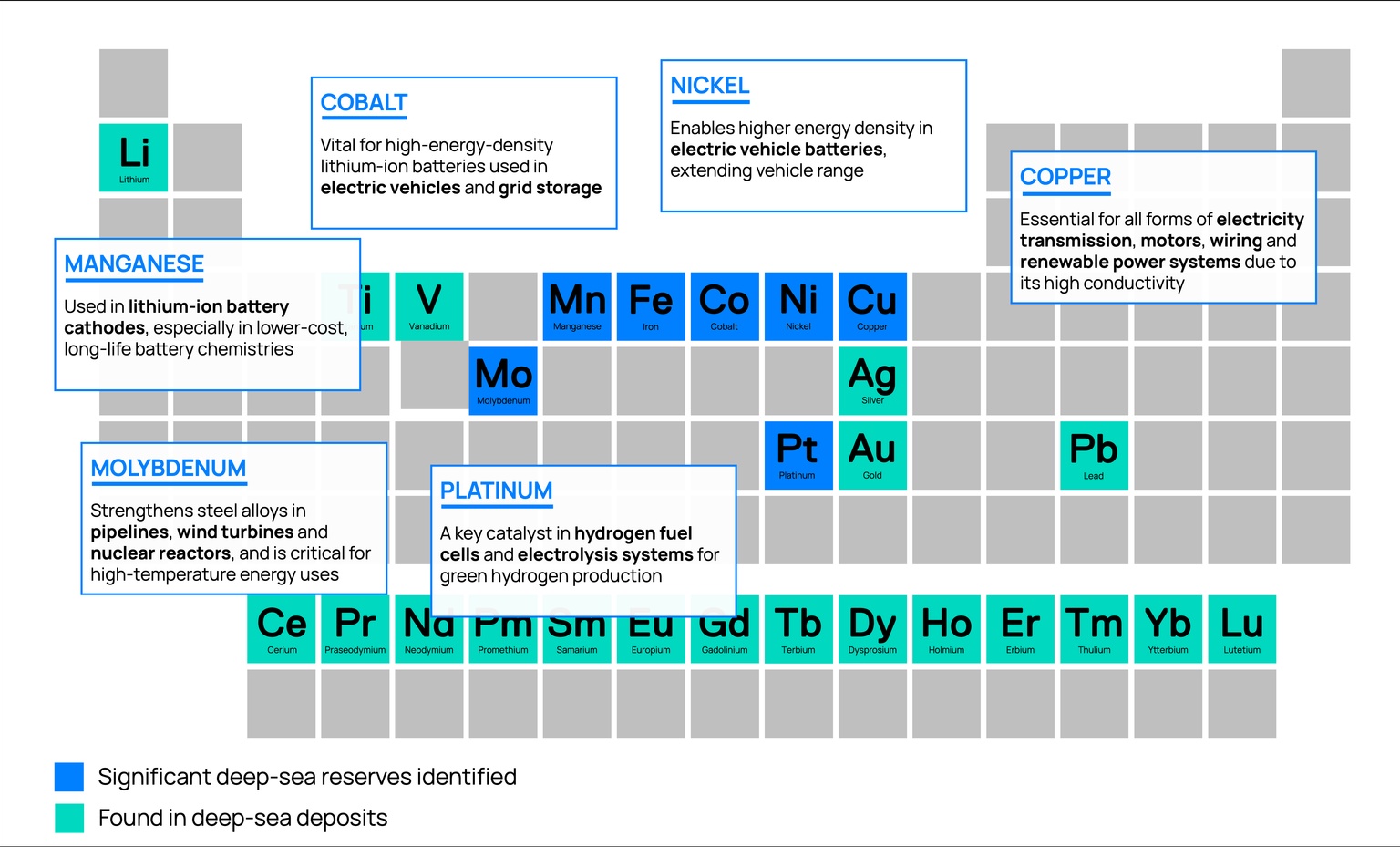
Treasures of the deep: The race for critical minerals has not been lost on the White House, which issued an executive order in April to “accelerate the responsible development of seabed mineral resources.”
But ocean-based mining raises all sorts of questions. The law of the sea is about as murky as Captain Jack Sparrow’s rum bottle. There are questions whether we know enough about the subsea mining ecosystems to not create new environmental issues in our push to quell others. And the global authority on the international seabed is set to announce global rules, but not everyone has given their approval.
So, will deep-sea mining play a big part in the future of mining? Let’s dive in.
To start with, there is unquestionably an abundance of minerals that can be found under the sea, including many of the ones we’re trying desperately to develop today.
One study found there is likely 20 times more metal tonnage to be found under the sea in just three types of deposits than has been identified in all land-based accumulations. The US Geological Survey estimates more nickel, manganese and cobalt can be found in a single deposit, known as the Clarion-Clipperton Zone, than all known global terrestrial occurrences combined. Consulting firm Arthur D. Little pegs that particular cache’s value at a staggering $18.4 trillion.
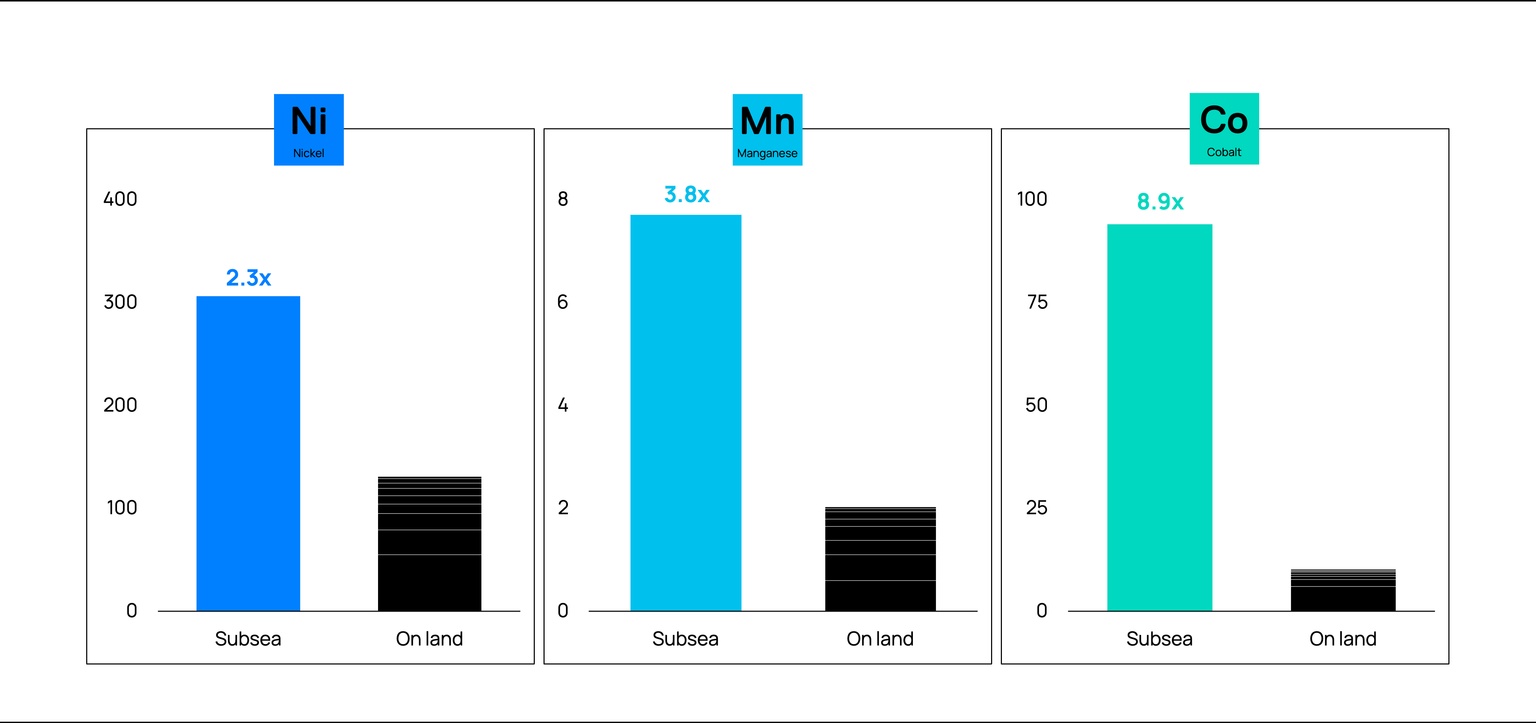
Source: US Geological Survey, Arthur D. Little
But tapping that wealth of minerals won’t be easy.
The pressure: It should go without saying, but operating deep underwater is hard — the human body is simply not designed for it. Let’s plunge down and see what goes wrong.
At 500 meters under the sea, where some of the shallowest subsea deposits are found, the pressure is already at 50 atmospheres. At this point, the overburden on an unprotected person would feel like every square inch of their body was balancing a grand piano. Death would be instant, but it gets worse as you go deeper.
Down at the abyssal plain 5,000 meters below the surface, an exposed human body would experience rapid and catastrophic compression. Skin would surprisingly be okay, being mostly water, but any organ containing gas would immediately and violently implode. Instantaneous human liquefaction.
Needless to say, all exploration and mining will be done by machines.
There are three main types of subsea ore bodies being considered for mining.
Polymetallic nodules: Best described as trillions of metallic potatoes sitting on the ocean floor, these nodules are formed by metals precipitating out of seawater, often around an original nucleus, like a shark tooth or piece of debris. They’re made up of many of the most important metals needed for electric vehicles: manganese, nickel, copper and cobalt.
Production is akin to running a fortified Roomba on the seabed, vacuuming up the concretions using an autonomous robotic collector, then sending them to a support vessel on the surface. The Metals Company, a Vancouver-based deep-sea mining exploration firm, successfully tested a nodule collector vehicle back in 2022, which was found to reduce the global warming potential of mining by 54% to 70% compared to land-based methods.
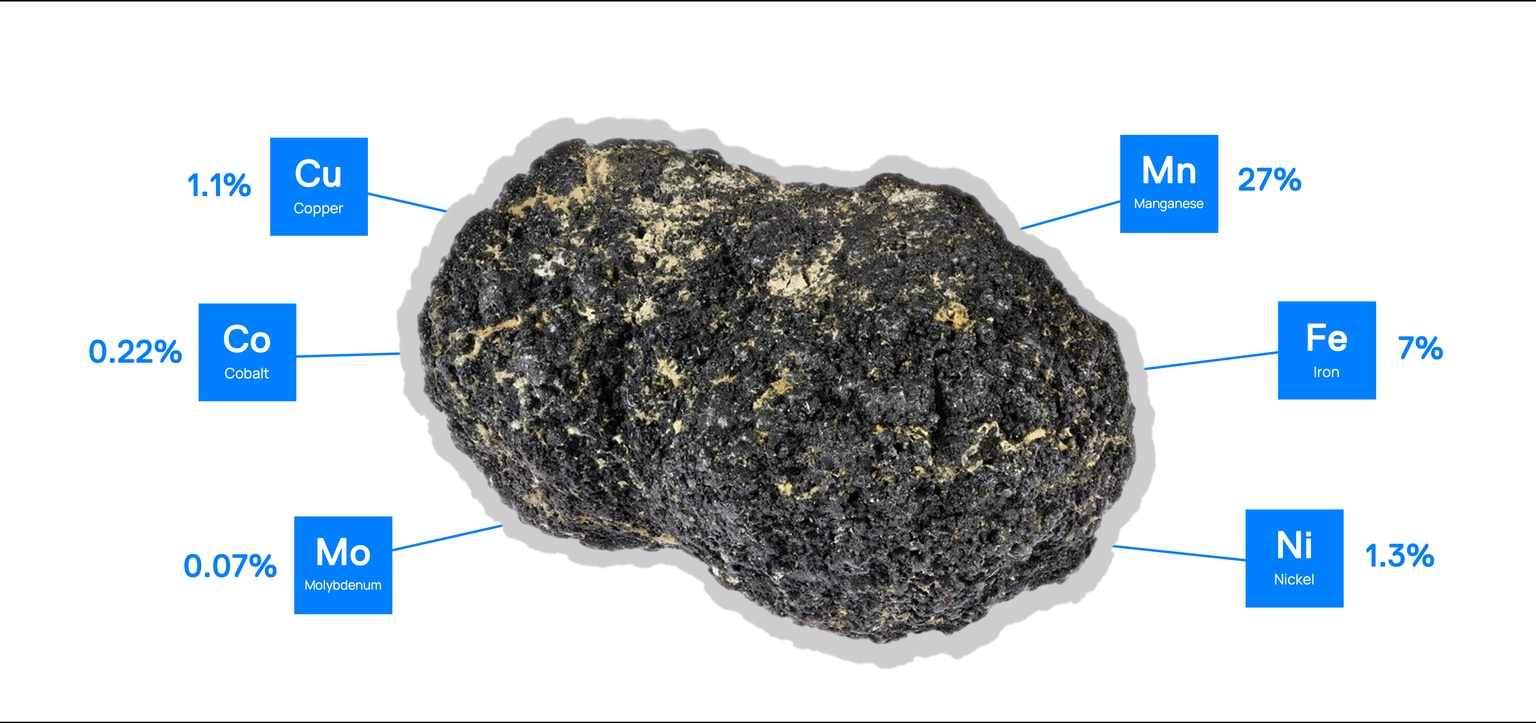
Source: Deep Sea Mining Inc.
Seafloor massive sulfides: In geologically active regions underwater, like mid-ocean ridges where two tectonic plates are spreading apart, hydrothermal vents called black-smokers spew out mineral-rich fluid. Once settled, the resulting ores are rich in copper, zinc, iron and precious metals comparable to high-grade land deposits.
To date, there’s no great plan on how these would be exploited. The underwater terrains around hydrothermal vents are so rugged, they make the South Dakota Badlands look like the Tuscan Italian countryside. Early thinking has remotely operated vehicles grinding and cutting the hard sulfide rock to break off ore that a mechanical collector can gather and bring to the surface.
Cobalt-rich crusts: Hard rock skins that form on the slopes or peaks of subsea volcanoes are rich in cobalt, nickel, manganese and other strategic minerals like platinum and rare earth elements.
Japan has already tested cobalt crust production using underwater crawlers and cutters. The government estimates there is sufficient cobalt on a single seamount to meet the country’s needs for 88 years and enough nickel stock for more than a decade’s use. Japan is looking to be ready to mine underwater at scale by the end of the decade.
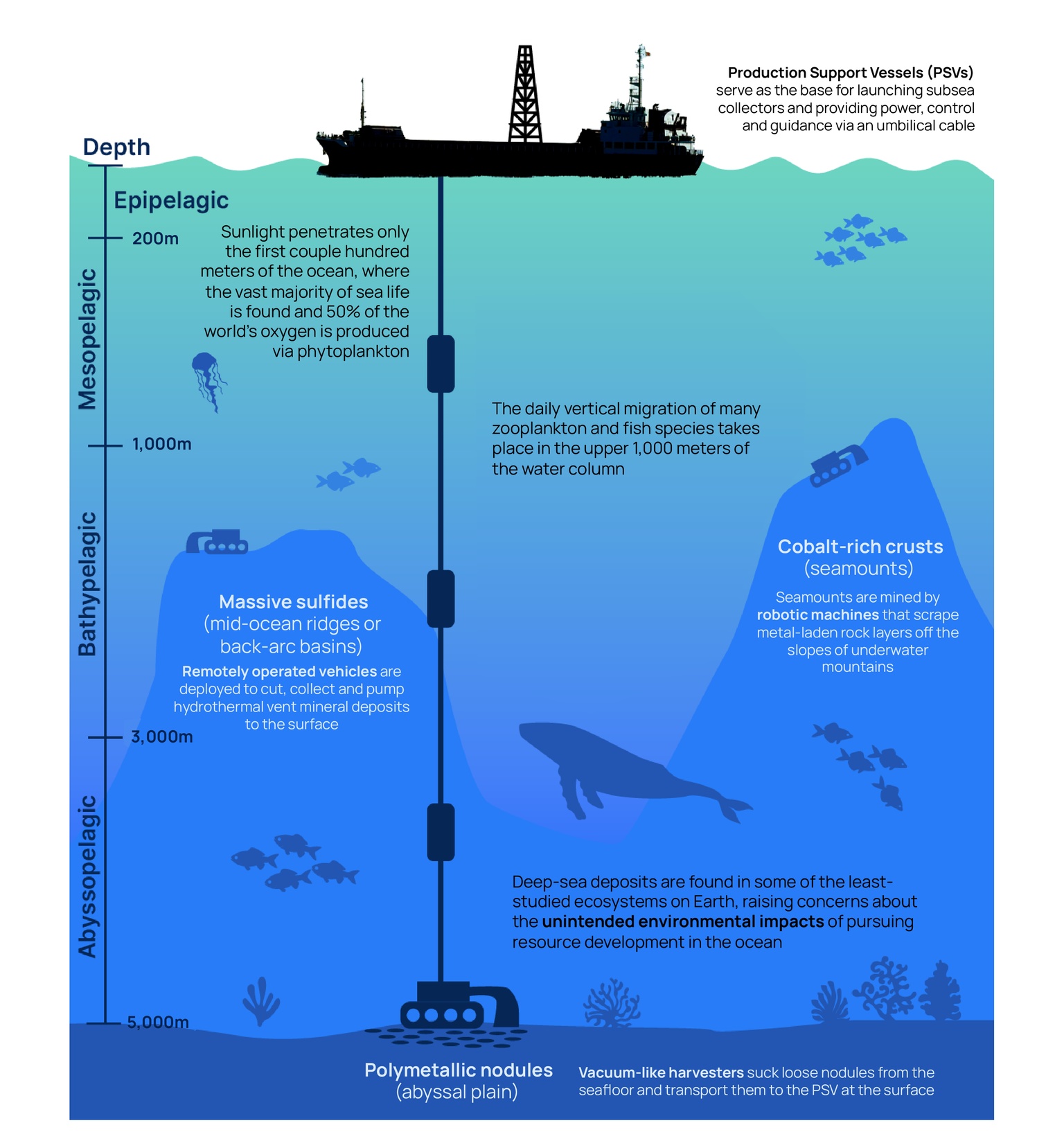
Source: Orennia
Japan’s plans involve mining within its own territorial waters, where its ownership is clearcut, but it’s not always that way.
Subsea mineral rights can be divided as those that lie within a country’s jurisdiction and those beyond.
National exclusive economic zones (EEZ): Countries are typically granted rights to any minerals found within 200 nautical miles of their shores and can be extended slightly through extensive continental slope research. Seabed mining in EEZs would be governed by national laws.
By pure geological chance, some of the smallest and poorest countries in the world are absolutely rich with subsea minerals. The Cook Islands, a self-governing nation of just 17,000 people, has one of the world’s largest nodule fields in its waters. Tonga and Kiribati are also metal potato hunting.
But rules governing mineral ownership in the middle of the oceans are more contentious.
The international seabed: More than half the world’s seabed is found outside coastal nation control. Under the UN Convention on the Law of the Sea (UNCLOS), these resources are deemed a “common heritage to mankind.” They are managed collectively by the Jamaica-based International Seabed Authority (ISA), which regulates mineral-related activities, including issuing permits and ensuring environmental protection.
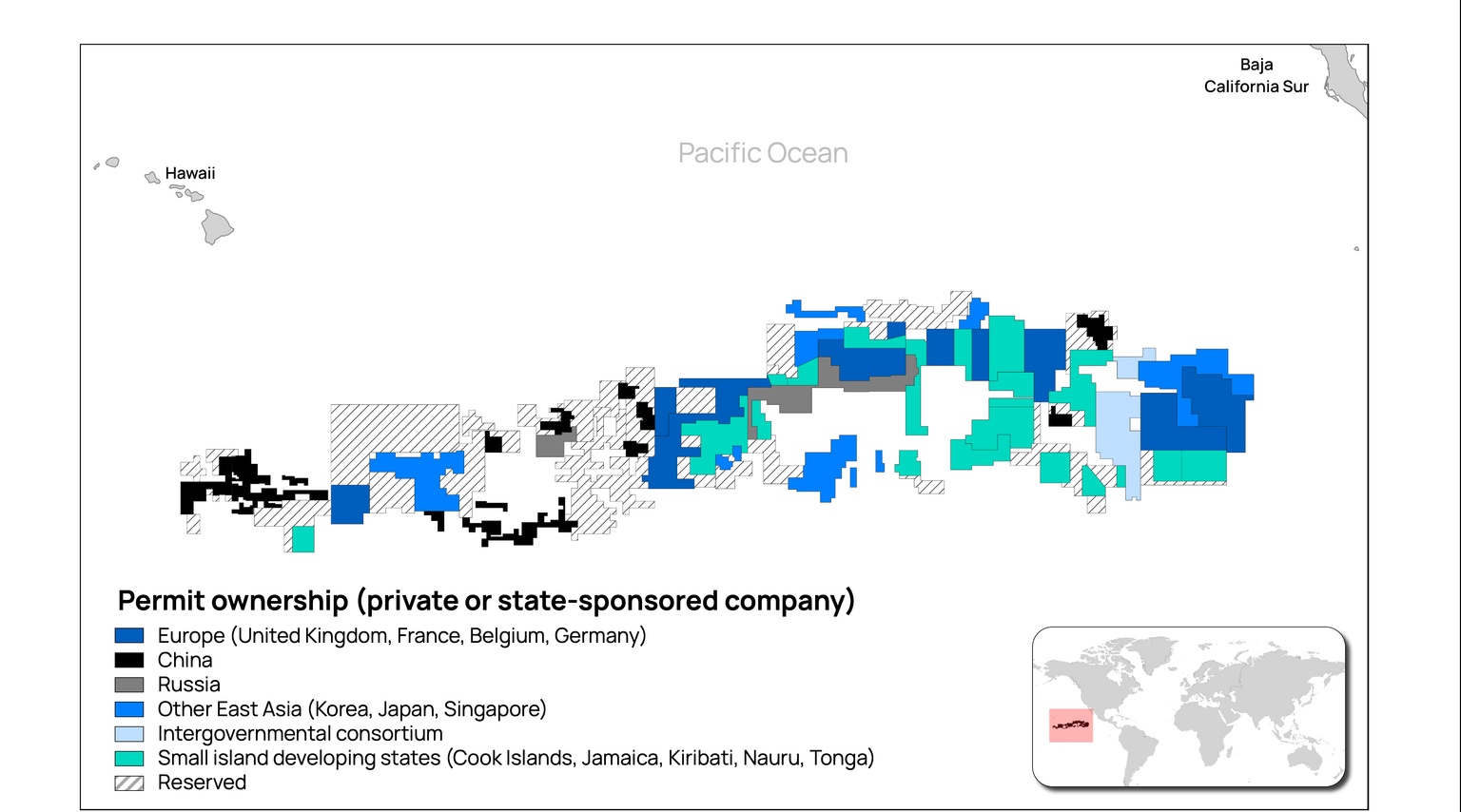
Source: International Seabed Authority
While there are clear commercial and energy transition drivers behind exploiting undersea minerals, there are justifiably some concerns about the impact of mining in ecosystems we know virtually nothing about.
Few vessels can even operate in the nodule-rich abyssal plane. As a result, less than 0.001% of the deep sea-floor has been sampled and analyzed in detail and a recent study determined 90% of creatures found in the Clarion-Clipperton Zone are currently undescribed by science.
Something is going to give on deep-sea mining. It could be the well-intentioned International Seabed Authority, whose mandate to protect the environment is quickly running up against the pressures of nation states trying to secure a supply of critical minerals.
China is a tough one to rule out. The Asian superpower has been courting small island developing states like Kiribati and Cook Islands as recently as April for access to their underwater resource troves to further exert its control over critical mineral supply chains.
And then there’s the American government, which feels vulnerable in its critical mineral supply chains yet hostile to any sort of global rules on mining the sea, not to mention having zero mineral claims in the Clarion-Clipperton Zone. A Trump administration executive order mandates being “consistent with applicable law” in waters beyond national jurisdiction, but the US is just one of 16 countries to not ratify UNCLOS. It’s unclear what the applicable laws would be and whether this could be the start of global interests undermining UN authority.
Bottom line: The idea of hunting for treasures underwater goes back to Aristotle, when Alexander the Great may have, but probably didn’t, study the subsea.
Technology to operate underwater has come a long way since the diving bell. As has our need for minerals. We may be living in the decade when thousands of years of innovations finally meets ambition.
Data-driven insights delivered to your inbox.